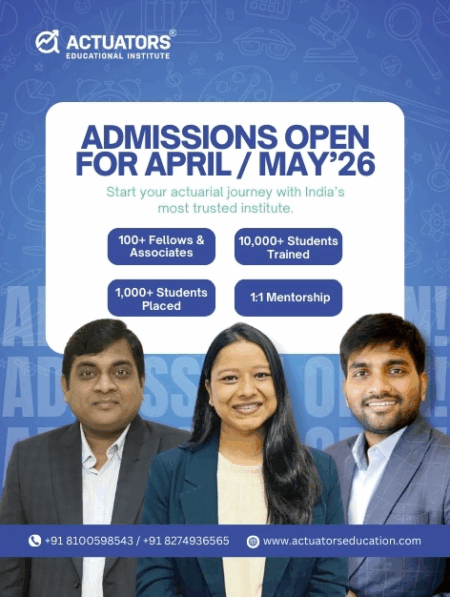How Actuaries Use Machine Learning in Real-World Scenarios
As data grows in volume, complexity, and velocity, traditional actuarial methods alone are no longer enough to meet the evolving demands of today’s industries. Enter machine learning — a powerful set of tools that enables actuaries to uncover deeper insights, automate processes, and enhance decision-making across sectors like insurance, pensions, banking, and healthcare.
Machine learning (ML), a subset of artificial intelligence (AI), enables computers to learn patterns from data and make predictions or decisions without being explicitly programmed. For actuaries, this is a game-changer. Rather than relying solely on static assumptions and historical averages, ML allows them to build adaptive, data-driven models that reflect the ever-changing realities of risk and behavior.
In this blog, we’ll explore how actuaries apply machine learning in real-world scenarios — from claims prediction to fraud detection and customer retention.
1. Claims Frequency and Severity Prediction
Industry: Insurance (Health, Auto, Life, Property)
Traditional Approach: Actuaries traditionally used Generalized Linear Models (GLMs) to estimate how often claims occur (frequency) and how costly they are (severity) based on factors like age, location, or vehicle type.
Machine Learning Application: With ML techniques such as gradient boosting, random forests, and neural networks, actuaries can process more granular data — including unstructured text, real-time data from telematics, or behavioral signals — to improve accuracy.
Example: In auto insurance, ML can analyze telematics data (speed, braking behavior, location) to more accurately predict accident risks and determine personalized premiums.
Impact:
- More accurate pricing
- Fairer premium models
- Reduced underwriting risk
2. Fraud Detection
Industry: Insurance, Banking
Traditional Approach: Fraud detection was based on red flags or predefined rules (e.g., multiple claims in a short period). These methods often missed sophisticated or emerging fraud patterns.
Machine Learning Application: ML models can learn complex patterns of fraudulent behavior by analyzing large datasets with known fraud outcomes. Algorithms like logistic regression, support vector machines (SVMs), and anomaly detection are commonly used.
Example: A health insurer may use ML to detect abnormal billing patterns by providers — such as overcharging for services or charging for services never rendered.
Impact:
- Early and accurate fraud detection
- Reduced losses
- Improved regulatory compliance
3. Lapse and Customer Retention Modeling
Industry: Life Insurance, Pensions
Traditional Approach: Actuaries used survival analysis and logistic regression to model policy lapses — i.e., when a customer stops paying premiums.
Machine Learning Application: ML models like decision trees and ensemble methods can incorporate behavioral data (call center logs, website interactions, payment history) to predict which customers are likely to lapse and why.
Example: A life insurance company uses ML to identify policyholders at high risk of lapse and targets them with retention campaigns or tailored offers.
Impact:
- Higher customer lifetime value
- Lower acquisition costs
- Personalized customer engagement
4. Underwriting Automation
Industry: Life and Health Insurance
Traditional Approach: Underwriters manually review medical histories, questionnaires, and lab reports to assess applicant risk.
Machine Learning Application: ML enables automated underwriting by predicting applicant risk based on historical acceptance patterns and third-party data (e.g., electronic health records, prescription databases).
Example: A life insurer uses ML to classify applications into low-risk (automatically approved), medium-risk (requires review), and high-risk (likely to be declined), speeding up the application process.
Impact:
- Faster policy issuance
- Lower operational costs
- Improved customer experience
5. Dynamic Pricing and Product Design
Industry: Property & Casualty, Health Insurance
Traditional Approach: Pricing was based on fixed rating factors and product templates.
Machine Learning Application: ML supports usage-based and behavior-based pricing models. It helps actuaries simulate how changes in pricing will affect demand, claims, and profitability.
Example: A home insurance company uses real-time IoT data (humidity sensors, smart locks) to offer dynamic premiums and incentives for risk-mitigating behaviors.
Impact:
- Greater product flexibility
- Improved profitability
- Alignment with customer behavior
6. Text Analytics and Natural Language Processing (NLP)
Industry: Claims, Legal, Compliance
Traditional Approach: Manual review of claim descriptions, legal reports, and customer feedback.
Machine Learning Application: Actuaries apply NLP to extract insights from unstructured text. Models like BERT or GPT can classify sentiment, detect themes, and summarize claims.
Example: NLP can automatically categorize claim reasons from free-text descriptions to streamline triage and reduce handling time.
Impact:
- Reduced administrative burden
- Faster response times
- Better claims management
7. Climate Risk and Catastrophe Modeling
Industry: Reinsurance, Property Insurance
Traditional Approach: Catastrophe models used historical event data and simulation.
Machine Learning Application: ML models integrate satellite data, weather simulations, and environmental data to dynamically assess exposure to climate risks.
Example: Actuaries can use deep learning to predict flood zones from satellite imagery and integrate this into risk pricing for property insurance.
Impact:
- Improved resilience modeling
- Accurate risk segmentation
- Support for ESG initiatives
Final Thoughts: The Human-AI Collaboration
Machine learning is not replacing actuaries — it’s empowering them. The best outcomes arise from combining actuarial judgment with machine intelligence. Actuaries bring domain knowledge, ethical responsibility, and regulatory understanding that ML alone cannot replicate.
However, to stay relevant, actuaries must upskill in:
- Data science and ML algorithms
- Programming languages (Python, R)
- Cloud platforms and big data tools
- Interdisciplinary communication
Conclusion
From automating underwriting to predicting catastrophic events, actuaries are applying machine learning in ways that transform industries. The integration of ML into actuarial work enhances efficiency, accuracy, and innovation — enabling actuaries to go beyond traditional boundaries and become strategic drivers of business value.
As machine learning continues to evolve, actuaries who embrace it will lead the future of risk analytics in a data-driven world.


